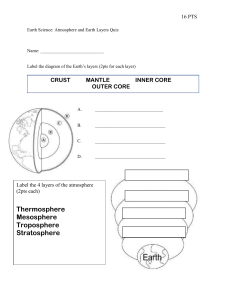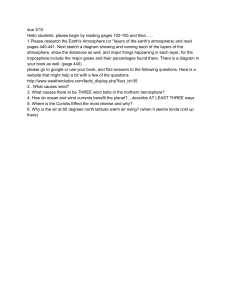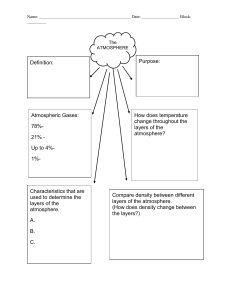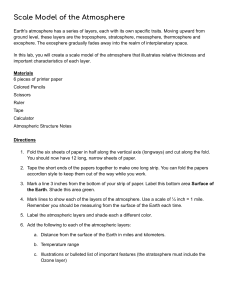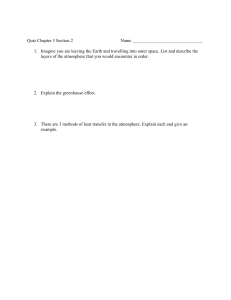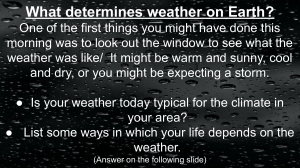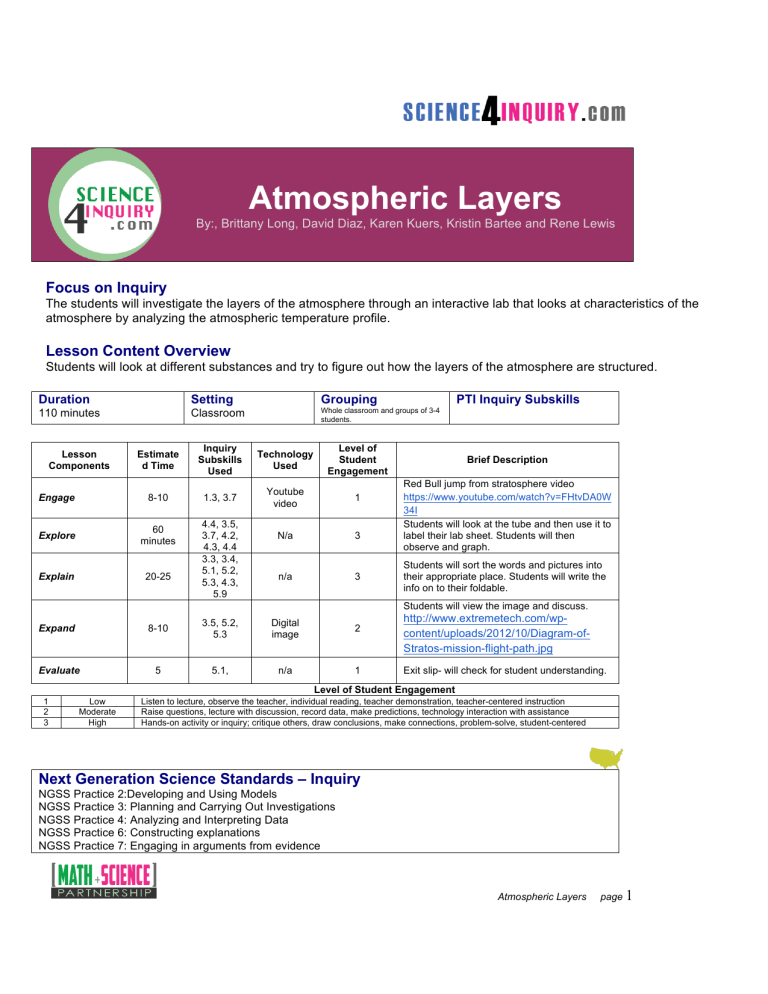
Atmospheric Layers By:, Brittany Long, David Diaz, Karen Kuers, Kristin Bartee and Rene Lewis Focus on Inquiry The students will investigate the layers of the atmosphere through an interactive lab that looks at characteristics of the atmosphere by analyzing the atmospheric temperature profile. Lesson Content Overview Students will look at different substances and try to figure out how the layers of the atmosphere are structured. Duration Setting Grouping 110 minutes Classroom Whole classroom and groups of 3-4 students. Estimate d Time Inquiry Subskills Used Technology Used Level of Student Engagement Engage 8-10 1.3, 3.7 Youtube video 1 Explore 60 minutes N/a 3 Explain 20-25 n/a 3 Lesson Components 4.4, 3.5, 3.7, 4.2, 4.3, 4.4 3.3, 3.4, 5.1, 5.2, 5.3, 4.3, 5.9 PTI Inquiry Subskills Brief Description Red Bull jump from stratosphere video https://www.youtube.com/watch?v=FHtvDA0W 34I Students will look at the tube and then use it to label their lab sheet. Students will then observe and graph. Students will sort the words and pictures into their appropriate place. Students will write the info on to their foldable. Students will view the image and discuss. Expand 8-10 3.5, 5.2, 5.3 Evaluate 5 5.1, Digital image 2 http://www.extremetech.com/wpcontent/uploads/2012/10/Diagram-ofStratos-mission-flight-path.jpg n/a 1 Exit slip- will check for student understanding. Level of Student Engagement 1 2 3 Low Moderate High Listen to lecture, observe the teacher, individual reading, teacher demonstration, teacher-centered instruction Raise questions, lecture with discussion, record data, make predictions, technology interaction with assistance Hands-on activity or inquiry; critique others, draw conclusions, make connections, problem-solve, student-centered Next Generation Science Standards – Inquiry NGSS Practice 2:Developing and Using Models NGSS Practice 3: Planning and Carrying Out Investigations NGSS Practice 4: Analyzing and Interpreting Data NGSS Practice 6: Constructing explanations NGSS Practice 7: Engaging in arguments from evidence Atmospheric Layers page 1 NGSS Practice 8: Obtaining, Evaluating and Communicating Information Next Generation Science Standards – Earth Science MS-ESS2-1. Develop a model to describe the layers of the atmosphere. Florida Science Standards - Inquiry SC.7.N.1.1 Define a problem from the seventh grade curriculum: use appropriate reference materials to support scientific understanding; plan and carry out scientific investigations of various types, such as systematic observations or experiments; identify variables; collect and organize data; interpret data in charts, tables, and graphics; analyze information; make predictions; and defend conclusions. SC.7.N.3.2 Identify the benefits and limitations of the use of scientific models SC.8.N.3.1 Select models useful in the investigations Florida Science Standards – Earth Science SC.6.E.7.9 Describe how the composition and structure of the atmosphere protects life and insulates the planet. Atmospheric Layers page 2 Materials and Advance Preparation Materials List Class set: All materials PER water bottle**Recommend 10 bottles** ● ● ● ● ● 16 oz vegetable oil (Thermosphere) 12 oz water (Mesosphere) 8 oz Dish soap (Stratosphere) 4 oz corn syrup (Troposphere) A water bottle (so that if a student shakes it, it will go back to normal) Student materials: ● Paper/Notebook ● Bottle with different materials ● Ruler ● Colored Pencils/Markers Blackline Masters 1.Atmospheric Profile Lab 2. Atmospheric Profile Graph 3. Description Cards 4. Exit Slip and answer key 5. Clip art pictures Advance Preparation 1. Teacher will create the lab (liquid with various densities) ahead of time. - At the bottom of the container pour 4 oz of corn syrup - On top of the corn syrup pour 8 oz of dish soap - On top of the dish soap pour 12 oz of water - On top of the water pour 16 oz of vegetable oil 2. Print and copy Blackline masters for students 3. Cut out description cards 4. Have an example for student help 5. Have engage video ready Lesson Information Learning Objectives 1. The student will be able to use the data collected in this lesson to correctly differentiate the layers of the atmosphere and explain specific characteristics about each. Prior Knowledge Needed by the Students ● Heat transfer ● What the atmosphere is (they would learn this from spheres) ● How to read a graph ● How to graph ● The difference between observe, infer, and predict (nature of science) Background Information Atmospheric Layers page 3 The Earth is broken into 5 layers, Geosphere, Biosphere, Hydrosphere, Atmosphere, and Cryosphere. Each sphere interacts with another making Earth work as a system. The atmosphere is an important layer that provides protection for life to survive on Earth. The atmosphere is broken into 4 layers beginning at the surface with the Troposphere. The Troposphere extends to about 11 kilometers and contains all of Earth’s weather, with temperatures decreasing with height. At about 11 kilometers the Stratosphere begins which contains the Ozone layer that protects Earth from the suns UV rays. Temperature in this layer increases with height and extends to about 50 kilometers. From 50 kilometers to about 87 kilometers the Mesosphere helps burn up meteors that enter the Earth’s atmosphere and temperature decreases with height. The final layer from 87 kilometers to space is the Thermosphere and temperature increases with height. This layer is responsible for the Aurora Borealis (northern lights). Lesson Procedure Engage Include guiding questions you might ask to help students. If you use a video (include the URL in your lesson plan instructions) or a book (the author, title and publication date), and include questions that you would ask before, during or after the video/book reading selection. Video: https://www.youtube.com/watch?v=FHtvDA0W34I 1. Students will watch video on Felix Baumgartner jumping from the Stratosphere. Teacher will say watch this video of Felix Baumgartner jumping from the stratosphere and pay attention to what he goes through as he travels towards the Earth. 2. Students will answer 5 questions about the video. Teacher says please answer these 5 questions on your lab sheet. 3. Students will silently answer 5 questions for about 5 minutes. Teacher will monitor ● When Baumgartner gets to his jumping spot at 24.2 miles from the Earth’s surface, hypothesize where you think he is located? Possible student answers could be: Space, Upper Atmosphere, Above the Earth. ● Explain why he jumped from a capsule and not an airplane? Possible student answers could be: Airplanes can’t fly that high, Capsules are easier to take that high up, You can’t jump out of an airplane that high, the capsule is similar to a space shuttle, an airplane is going too fast. ● Explain why you think he was dressed like an astronaut. Possible student answers could be: It would give him oxygen and protect him from the harsh elements of space, You can’t breathe that high up, It’s really cold. ● Hypothesize why you think the control center is concerned about him passing out? Possible student answers could be: If he passes out he won’t be able to pull his parachute open, it wouldn’t be safe for him to be passed out. 4. Students will share answers with the class. Teacher will ask and go over questions Explore This should be a student-centered, hands-on activity that teaches your students about science. No lectures or direct teaching allowed. Please be as hands-on as possible. Also, please provide enough detail so that Dr. Blanchard could teach your lesson based on what you have included in these steps. Part 2: Students will look at a tube filled with different liquids of different densities and see a 4 layered look. They will then make 3 qualitative observations about the tube and put it in a chart. Possible student answers may be: The layers stack on top of each other, some layers are bigger than others, they don’t seem to mix, and they don’t affect each other. Answers may also vary. Atmospheric Layers page 4 Part 3: Students will use data given of temperature at different altitudes and will graph them on the chart provided. After graphing the temperatures, students will be able to see how the temperature changes at each level in the atmosphere. Student answers should follow this pattern: Temperature in layer D will decrease, Temperature will increase in Layer C, Temperature will decrease in Layer B, and Temperature will increase in Layer A. Part 4: Graph Analysis Questions- After students complete the graph they will answer the following questions. ● What do you notice about the temperatures on the graph? Possible student answers may be: the temperatures are changing, some of the temperatures increase and some of them decrease, the temperatures in layer D decrease, layer C increase, layer B decrease ,and layer A increase, temperatures are getting colder in layer D, warmer in layer B, Colder in layer C, warmer in Layer B. ● How are the temperatures changing? Look at the independent and dependent variables Possible student answers may be: Temperatures are changing with altitude, temperatures are getting colder and warmer with height, As you go up in the atmosphere the temperatures change. ● Hypothesize why the temperature stays the same as altitude (height) increases at each black line? Possible student answers may be: the temperature stays the same, it’s showing the next layer, layers are slowing transitioning into the next layer. ● Compare layers A and C. Hypothesize why you think the temperatures are increasing. Possible student answers may be: It’s getting closer to the sun, answers may vary because it’s their prediction on why they think temperature changes. ● Compare layers B and D. Hypothesize why you think the temperatures are decreasing. Possible student answers may be: further you get away from the ground the colder it gets, answers may vary because it’s their prediction on why they think temperature changes. Explain Include guiding questions you might ask students during the EXPLORE activity. You should have at least 10-15 questions to guide student discussion and learning. Part 5: Layer Identification- Students will use cards that have descriptions on them. These descriptions explain basic characteristics of the layers, like temperature and features found in each layer. The students will look at the card and figure out which layer they belong to and fill in the chart. Once they have filled in the descriptions they will identify which layer is which. After that is complete students will either draw or teacher can print out pictures of what features are found in each layer. For example an airplane in the Troposphere. After that is complete students will answer the following analysis questions. ● ● In order state the layers of the atmosphere from the ground up Possible student answers may be: troposphere, stratosphere, mesosphere, thermosphere. If the student gets the layering wrong they could be in any order. List what objects can be found in Each Layer. Possible student answers may be: Troposphere-air plane, Stratosphere-ozone layer, Mesosphere- meteors, Thermosphere-Aurora Borealis. Atmospheric Layers page 5 ● What can you infer about the reason why commercial airplanes fly in layer D? Possible student answers may be: It’s as high as they can go, it’s too hot in the stratosphere, what airplanes are made of will not hold up in higher layers. Answers may vary because it’s based off students reasoning. ● Hypothesize how you think the atmosphere helps living things survive on Earth Possible student answers may be: answers may vary because it’s based off students predictions. Atmosphere gives us oxygen. Atmosphere gives us weather, Atmosphere protects us from meteors and UV rays. ● Contrast 3 ways in which heat is transferred through the layers. Possible student answers may be conduction, convection, and radiation. ● Predict what would happen on Earth without the Stratosphere or if it had holes Possible student answers may be UV Rays would increase. ***MISCONCEPTION is that it changes global temperature*** ● Summarize what happens in the Troposphere- Student answers will vary, but should be based off description cards. Summarize what happens in the Stratosphere- Student answers will vary, but should be based off description cards. Summarize what happens in the Mesosphere- Student answers will vary, but should be based off description cards. Summarize what happens in the Thermosphere- Student answers will vary, but should be based off description cards. ● ● ● Expand Include a similar student centered activity that will allow students to practice or connect what they have just learned in Explore. This is not an opportunity to introduce a new topic, but to provide enrichment on the topic of this lesson. Students will watch the full video of Felix Baumgartners Jump and answer the following questions: Video is 20 minutes http://www.extremetech.com/wp-content/uploads/2012/10/Diagram-of-Stratos-mission-flight-path.jpg 1. Describe why Baumgartner slows down when he reaches the lower levels of the stratosphere. Possible student answers may be because he pulled his parachute, friction began slowing him down, air resistance slowed him down. 2. Analyze the benefits of using a weather balloon for the jump instead of a plane. Possible student answers may be cheaper to make, can go higher in the atmosphere, easily repeated, airplanes fly too quickly. 3. Pretend you are trying to break Baumgartner’s record. What are some concerns you would need to address before the day of the jump? Possible student answers may be parachute working, cold feet, good weather conditions, balloon working, capsule fully operational. Answers may vary. 4. Predict why no one has previously jumped from the height that Baumgartner jumped from. Possible student answers may be people were scared, no technology was able to get that high in the atmosphere. 5. Predict why Baumgartner did not jump from a higher height? Possible student answers may vary but could be along the lines of human body can’t handle anything higher, technology is limited to that height. Evaluate FORMAL EVALUTION a. Attach a FORMAL EVALUATION (1-3 questions) on a separate sheet of paper that you have developed to use as your evaluation tool. b. For each question, identify in parentheses at the end of the criteria the GLE (GLE#___) and/or Learning Objective (LO#___) you are assessing for your lesson. If you use an Inquiry GLE, please note it as INQ GLE #___. Atmospheric Layers page 6 INFORMAL or OPTIONAL EVALUATIONS 1. Summarize in a few sentences the atmosphere and how it works. 2. What stood out the most about each layer? WRAP UP. Bring the lesson to a conclusion by students sharing sharing with each other what they have learned from the activity and teacher addressing any misconceptions. Supplementary Resources Include links to resources that the teachers and students might find useful in learning more about this topic. Each resource should be in APA citation style and be followed with a one sentence annotation that notes appropriate age or grade level. Teachers Diagram of Stratos Mission Flight. (2016). Red Bull. Retrieved from http://www.extremetech.com/wp- content/uploads/2012/10/Diagram-of-Stratos-mission-flight-path.jpg Image depicting what happened and when during the Baumgartner’s jump. CITATION OF SOURCES. Where did you get the idea/materials for this lesson?(Put the author/date/book name or the Name of the website and the complete URL). I/We used the following resources to build our lesson: @. (n.d.). The tech behind Felix Baumgartner’s stratospheric skydive | ExtremeTech. Retrieved September 10, 2016, from http://www.extremetech.com/extreme/137521-the-tech-behind-felix-baumgartners-stratosphericskydive R. (2012). Felix Baumgartner's supersonic freefall from 128k' - Mission Highlights. Retrieved September 10, 2016, from https://www.youtube.com/watch?v=FHtvDA0W34I Kristin Bartee, Brittany Long, David Diaz, Karen Kuers, and Rene Lewis __ __ Yes, I cited all materials and resources used in this lesson. Lesson author signature Atmospheric Layers page 7 Blackline Masters 1: Atmospheric Profile Labet Layers of Atmosphere Standard: SC.6.E.7.9- Describe how the composition and structure of the atmosphere protects life and insulates the planet. Learning Target: Students will describe the different layers of the atmosphere and its importance Part 1: Video Clip 1. When Baumgartner gets to his jumping spot at 24.2 miles from the Earth’s surface, hypothesize where you think he is located? ____________________________________________________ __________________________________________________________________________________________________ __________________________________________________________________________________________________ 2. Explain why he jumped from a capsule and not an airplane?_________________________________ __________________________________________________________________________________________________ __________________________________________________________________________________________________ 3. Explain why you think he was dressed like an astronaut_____________________________________ __________________________________________________________________________________________________ __________________________________________________________________________________________________ __________________________________________________________________________________________________ 4. Hypothesize why you think the control center is concerned about him passing out?_____________________________________________________________________________________________ __________________________________________________________________________________________________ __________________________________________________________________________________________________ Part 2: Layer Tube Look at the tube with the 4 different layers and make 3 qualitative observations about what you see. Qualitative Observations: 1. 2. 3. Part 3: Graph Atmospheric Layers page 8 Use the data below and graph the temperatures on the atmospheric temperature profile. Altitude (Km) 0 3 8 10 12 20 30 40 52 54 60 70 80 87 89 100 125 135 140 Temperature (C) 20 -15 -30 -40 -40 -35 -30 -15 -5 -5 -20 -60 -80 -95 -95 -60 -20 40 70 Part 4: Graph Analysis 1. What do you notice about the temperatures on the graph?________________________ _______________________________________________________________________________________ 2. How are the temperatures changing? Look at the independent and dependent variables. _______________________________________________________________________________________ 3. Hypothesize why the temperature stays the same as altitude (height) increases at each black line?___________________________________________________________________ _______________________________________________________________________________________ _______________________________________________________________________________________ 4. Compare layers A and C. Hypothesize why you think the temperatures are increasing.________________________________________________________________________ _______________________________________________________________________________________ _______________________________________________________________________________________ _______________________________________________________________________________________ Atmospheric Layers page 9 5. Compare layers B and D. Hypothesize why you think the temperatures are decreasing. _______________________________________________________________________ _______________________________________________________________________________________ _______________________________________________________________________________________ _______________________________________________________________________________________ Part 5: Layer Identification Look at cards and figure out which layer is represented by the description. Layer A Layer B Layer C Layer D Description of each layer Layer of the Atmosphere 1. In order state the layers of the atmosphere from the ground up._____________________ _________________________________________________________________________________________ 2. List what objects can be found in Each Layer________________________________________ _________________________________________________________________________________________ _________________________________________________________________________________________ 3. What can you infer about the reason why commercial airplanes fly in layer D?______ _________________________________________________________________________________________ _________________________________________________________________________________________ _________________________________________________________________________________________ 4. How you think the atmosphere helps living things survive on Earth.____________ __________________________________________________________________________________________ __________________________________________________________________________________________ 5. Contrast 3 ways in which heat is transferred through the layers_____________________ __________________________________________________________________________________________ __________________________________________________________________________________________ Atmospheric Layers page 10 6. Predict what would happen on Earth without the Stratosphere or if it had holes___________________________________________________________________________________ _________________________________________________________________________________________ _________________________________________________________________________________________ 7. Summarize what happens in the Troposphere________________________________________ __________________________________________________________________________________________ __________________________________________________________________________________________ 8. Summarize what happens in the Stratosphere________________________________________ __________________________________________________________________________________________ __________________________________________________________________________________________ 9. Summarize what happens in the Mesosphere_________________________________________ __________________________________________________________________________________________ __________________________________________________________________________________________ 10. Summarize what happens in the Thermosphere_____________________________________ __________________________________________________________________________________________ __________________________________________________________________________________________ Part 6: Full Stratosphere Jump 1. Describe why Baumgartner slows down when he reaches the lower levels of the stratosphere. ___________________________________________________________________________ __________________________________________________________________________________________ __________________________________________________________________________________________ 2. Analyze the benefits of using a weather balloon for the jump instead of a plane. __________________________________________________________________________________________ __________________________________________________________________________________________ __________________________________________________________________________________________ 3. Pretend you are trying to break Baumgartner’s record. What are some concerns you would need to address before the day of the jump?_____________________________________ __________________________________________________________________________________________ __________________________________________________________________________________________ 4. Predict why no one has previously jumped from the height that Baumgartner jumped from.____________________________________________________________________________ __________________________________________________________________________________________ __________________________________________________________________________________________ 5. Predict why Baumgartner did not jump from a higher height?_______________________ _________________________________________________________________________________________ __________________________________________________________________________________________ Atmospheric Layers page 11 Blackline Masters 2: Atmospheric Profile Graph Atmospheric Temperature Profile Atmospheric Layers page 12 Blackline Masters 3: Description Cards Thermosphere The air is very thin, and temperature increases with height. Both the space shuttle and the International Space Station orbit in the middle-to-upper part of this layer. Also, the Aurora Borealis (northern lights) occurs in this layer. Thickest layer, and our boundary into space. Mesosphere This is the coldest layer. Although the air is thin, it’s still thick enough to burn up meteors due to friction. Second thickest layer and temperature decreases with height. Stratosphere Contains the ozone layer (which protects Earth from ultraviolet (UV) Rays.) Some weather balloons can reach the lower part of this layer. Temperature increases with height. Troposphere This is the layer closest to Earth, where all living things are found. It is also the layer where weather occurs and jets fly. As you increase in height the air pressure decreases. Atmospheric Layers page 13 Blackline Masters 4: Exit Slip and Answer Key Atmospheric Layers Exit Slip 1. Weather occurs in which layer of our atmosphere? (SC.6.E.7.9) a. b. c. d. Troposphere Stratosphere Mesosphere Thermosphere 2. What does the ozone layer protect living things on Earth from? (SC.6.E.7.9) a. b. c. d. Visible light Infrared rays Ultraviolet radiation Carbon dioxide 3. Which layer of the atmosphere protects the Earth’s surface from being hit by most meteors? (SC.6.E.7.9) a. b. c. d. Troposphere Stratosphere Mesosphere Thermosphere 4. How does the temperature change in the troposphere (SC.6.E.7.9) a. b. c. d. Increases Decreases Increases then decreases Stays the same 5. As you rise higher in the atmosphere, air pressure (SC.6.E.7.9) a. b. c. d. Increases Decreases Doesn’t change First increases, then decreases Atmospheric Layers page 14 Atmospheric Layers Exit Slip Answer Key 1. Weather occurs in which layer of our atmosphere? (SC.6.E.7.9) a. b. c. d. Troposphere Stratosphere Mesosphere Thermosphere 2. What does the ozone layer protect living things on Earth from? (SC.6.E.7.9) a. b. c. d. Visible light Infrared rays Ultraviolet radiation Carbon dioxide 3. Which layer of the atmosphere protects the Earth’s surface from being hit by most meteors? (SC.6.E.7.9) a. b. c. d. Troposphere Stratosphere Mesosphere Thermosphere 4. How does the temperature change in the troposphere (SC.6.E.7.9) a. b. c. d. Increases Decreases Increases then decreases Stays the same 5. As you rise higher in the atmosphere, air pressure (SC.6.E.7.9) a. b. c. d. Increases Decreases Doesn’t change First increases, then decreases Atmospheric Layers page 15 Blackline Masters 5: Clip Art Pictures Atmospheric Layers page 16 Atmospheric Layers page 17
